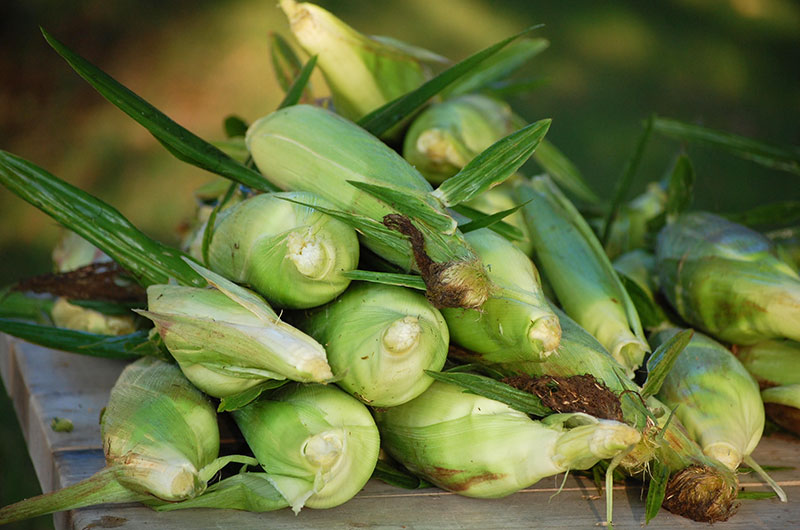Ever thought of trying to grow corn?
Bob Avakian tried it for the first time last summer, in a thousand-square-foot two-family garden in Sweetened Water Farm, off West Tisbury Road in Edgartown. The effort led to a kind of corny, summer-long Armageddon – relentless pestilential assaults and near-total crop failure. But Bob, the owner of Vineyard Construction Services, need not feel singled out: His neighbors over at Morning Glory Farm, the acknowledged Island masters of the corn-growing arts for more than thirty years, confront the same challenges every year too. And even they don’t always triumph.
Last year the Athearn family of Morning Glory Farm planted about twenty-three acres of corn in five fields in Edgartown and West Tisbury, hoping that each acre would yield as much as 12,000 ears (a thousand dozen, as farmers measure it) at the peak of the growing season – though the harvest is seldom that good. They plant as many as a dozen varieties, depending on weather and demand. Like Bob Avakian, Morning Glory faces an early season challenge from the deer. As farmers, the Athearns are permitted to shoot a deer in their fields whenever they find one there (though they rarely do); Bob, barred from doing the same thing in his own neighborhood, installed a six-foot fence. But then, he says, “about the time the tassels appeared on the corn so did an invasion of aphids.”
Aphids can cover the leaves so thickly that they look like a kind of fuzz. Jim Athearn, who founded Morning Glory with his wife Debbie in 1979, says that most of the time, there’s no real downside to aphids except unsightliness. “I went to SBS [in Tisbury] and bought some organic remedy for that,” says Bob, “but suffered some damage to the corn.”
Next up, Bob says: ear worms. Jim has battled this problem since his very first crop in 1970, which he sold to a market in Edgartown and had to buy right back because of an infestation of worms. Nowadays, Morning Glory asks its customers to take the long view: “Worms are a fact of life on Martha’s Vineyard,” reads a sign at the corn bin in the farm stand. “We do our best to keep them out, but occasionally they are present in the corn. If the damage is in the tip, we feel it is still good corn. It can easily be trimmed with no loss, and the corn is worth it.” Last summer Bob looked at things in the same way, saying the worms “did not bother me too much. I just cut away that part of the corn. It still tastes the same.” But he confesses: “Other people found it totally unappetizing.”
As his “slight” harvest approached, Bob felt he might be in the clear. But then “some creature began eating husks and kernels, leaving a bare cob on the stalk.” He talked with other gardeners, some of whom thought it might be crows, and others who guessed raccoons – “even with the fence.”
Another possibility: blackbirds – at times the most incorrigible threat of all, since they have “nothing to do but fly around all day and find the tastiest corn,” according to Daniel Athearn, Jim and Debbie’s youngest son, “so they pick the best.” Last August, blackbirds wiped out half the crop in one block of corn, which on this particular field in Edgartown was sixteen rows wide and nearly four hundred feet long.
The Athearns combat blackbirds with every imaginable weapon – whistlers that sound like fireworks going off, recorded gunshots – and at times they have considered what might be thought of as weird experiments. “The most recent one I remember [reading about] is spraying Concord grape extract onto the leaves of the plants,” says Simon Athearn, Dan’s older brother. “It has a diuretic in it that throws off the birds’ metabolism. Didn’t work that well in the trial.”
But like the Athearns, Bob Avakian will not quit. “This year, I am planting more corn, some to share (with the animals),” he says. “I will be ready for
the aphids and ear worms with some of the organic pesticides. Last year I put a net over my tomato plants, which stopped the crows from pecking my tomatoes. I may try that on some of the corn – not sure. Anyways, it looks like another experimental year.”
Tom Dunlop is the author of Morning Glory Farm and the Family that Feeds an Island (Vineyard Stories, 2009), with photographs by Alison Shaw and recipes from the Morning Glory farm stand, restaurants, and caterers.
Corn recipes from Morning Glory Farm and the Family that Feeds an Island
Chesca’s Roasted Corn Chowder
Jan Buhrman’s Corn Pudding Soufflé
Morning Glory Corn Muffins







